KTX Guide – How to Use KTX, Cheapest Tickets & More

Korea has one of the best public transport systems in the world. Not only is it extremely efficient, cheap and convenient, but it’s also very fast!
The KTX forms a part of Korea’s fantastic infrastructure. The KTX is a bullet train that can reach speeds exceeding 300km/h. These trains connect many of Korea’s largest cities and they offer a form of transport that can rival, and in many cases even replace planes.
KTX stands for Korea Train E(X)press and they are currently the highest class of train on the Korail rail network. There are also other trains such as the ITX (Intercity Train E(X)press) and the Mugunghwa-ho trains.
Both of these offer similar services to the KTX, however, they normally operate on shorter routes and at lower speeds. If you are traveling between far cities (such as Seoul to Busan, or Seoul to Daegu), the KTX is the train to take.
With the extreme speeds of the KTX, it can make even the longest trips pass quickly. The trip from Seoul to Busan can take over five hours by bus, but the KTX can cut that to more than half (two hours and 15 minutes on the fastest KTX to be exact!).
With that being said, this guide will teach you everything that you need to know about using the KTX. From ticketing procedures and etiquette all the way to the KTX network and more. This is my guide for using KTX in Korea.
This post contains affiliate links. For more information, please refer to my affiliate disclaimer.
Purchase the Korea Rail Pass – one of the best ways to save money on the KTX!
Why Use KTX?

To begin with, I want to cover why you even need to take the KTX. What puts it above other transport methods such as slow trains, buses, planes, or even hiring a car and using that?
The KTX is not the fastest method of travel in South Korea – that title belongs to planes. Planes can cover the Seoul to Busan route in one hour, less than half that of the KTX. However, the KTX does have a few benefits.
Firstly, it is cheaper than most flights. While it is possible to find cheap flights at times, it’s rare to find them cheaper than KTX tickets. Mid-week plane tickets can be as low as $30 (or less if you are very lucky!). However, the KTX does tend to be cheaper usually.
Further, the KTX is far more convenient in most cases. Taking a flight means going to the airport. Getting to Gimpo Airport from central Seoul takes around 40 minutes, and from Gimhae Airport to Busan Station at the other end takes a further 40 minutes. In the end, the KTX might actually be faster since it goes arrives at a central location in both cities.
Of course, you can book private airport transfers or taxis for the airports at both ends of the trip, however, this is a further cost that makes traveling by air significantly more expensive.
The KTX is also more comfortable in regards to ease of use. Once it arrives at the station (usually early), simply walk on with your bags, take your seat, and wait until it arrives at the other end. Once it does, walk-off. It’s that simple. Usually, you won’t even get your tickets checked. Airports and planes are, of course, far less simple.
While buses and slow trains are cheaper than KTX, they are also far slower and often less comfortable. Although buses often go for around half the price of a KTX ticket, they take around 5 hours to make the Seoul to Busan trip. Further, they are heavily reliant on traffic… Something that can add hours to a trip if you hit either city at the wrong time.
The same goes for cars. While hire cars are relatively cheap in Korea, the KTX is still a far more comfortable and easy method of transportation. Not only do you not have to worry about traffic (which again, can add hours to a trip), but you don’t have to pay attention to the roads. Simply get on the train and do what you want! Further, if you aren’t entirely comfortable driving on Korean roads, or don’t know the route fully, it’s better safe than sorry.
Overall, KTX isn’t the cheapest option but it is the fastest. Even compared to planes (in most cases), the KTX is actually a faster transport method. If saving money is key for you, take a bus. There is no denying though, that the KTX is a fantastic method of transport.
If you are interested in purchasing Korail passes or checking out what activities there are to do in Busan and Seoul, feel free to check out the banner below!
KTX Network

The KTX network serves most major cities in South Korea. All lines begin in Seoul, and they run down to Busan in the south-east, Gangneung in the north-east, and Mokpo in the south-west. That is to say, they reach every corner of the country.
There are five main KTX lines – the Gyeongbu line, Honam line, Gyeongjeon line, Jeolla line, and Gyeonggang line. There is also a sixth line, the SRT line. This line operates very similarly to the others, but it is run by a separate company (not Korail). However, it still uses the same ticketing system and operates almost exactly the same for customers.
Although there are a few smaller cities across the country that aren’t served by the network, the vast majority of cities are. If they aren’t served by high-speed trains such as the KTX, there is likely a slower train that reaches the destination.
Save money travelling on the KTX with the Korail Pass!
Cost & Ticketing

KTX Tickets.
Although I would love to give a definite answer to the question of cost, it’s impossible to do so. KTX ticket prices vary depending on a lot of factors. However, you can expect tickets from Seoul to Busan to cost around 60,000KRW, tickets from Seoul to Daejeon to cost around 30,000KRW and around 40,000KRW to Daegu.
The prices will fluctuate depending on factors such as the day (weekends are more expensive as are holiday dates), when you purchase your tickets (last minute tickets are naturally significantly more expensive than pre-booked tickets), and the final destination.
Another factor that can change the price of the KTX is the train that you take. Not all KTX trains are equal – some are faster than others. The fastest KTXs will complete the journey in two hours and 15 minutes, whereas the slower ones will take over 3 hours.
These trains have different schedules, and the faster ones will be more expensive. However, it’s better to plan your trip based on the train that fits your schedule, rather than the one that is fastest.
The cheapest KTX tickets usually go for 10,000KRW to 15,000KRW. These tickets will take you from Seoul to Suwon (one of the satellite cities of Seoul). The most expensive tickets that run to Busan can start around 45,000KRW.
First class tickets are also available for those who would like seats with more space and the other comforts that are associated (such as snacks, water, and access to vending machines). These tickets cost around 20,000KRW more normally, and may or may not be worth it depending on your needs.
In regards to the most common route – Seoul to Busan, tickets start at around 40,000 and can reach around 90,000KRW depending on the above mentioned factors. In short, these are the factors that can influence the cost of a KTX ticket:
- Time (weekends/evenings and public holidays cost more)
- Train type (there are many different KTX trains. Some are faster, while some are older and slower)
- Booking date (the closer to the departure date you book, the more expensive)
- Class (first class/economy)
Purchasing Tickets
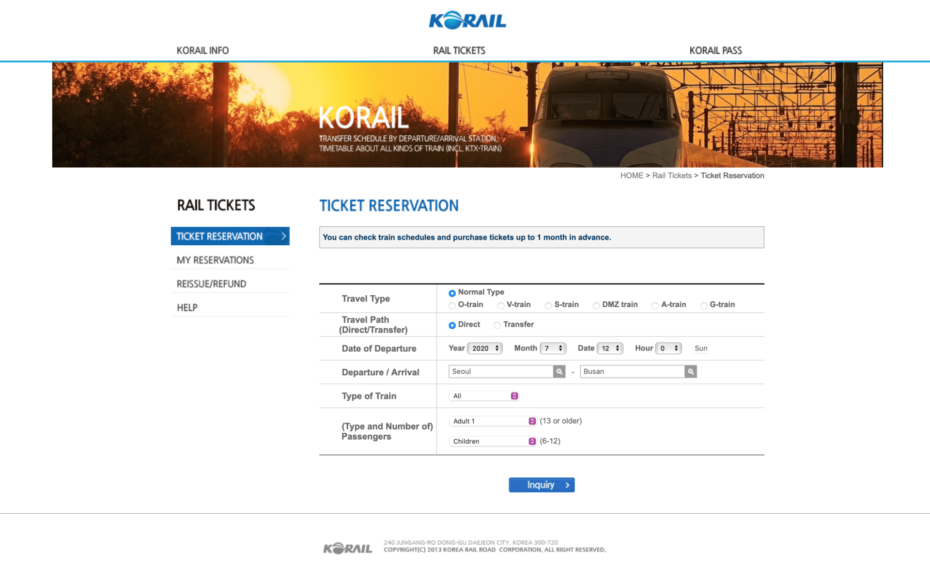
Tickets for not only the KTX, but nearly all Korail trains can be purchased on Korail’s website. This website is far from the best, and many people are surprised to find that this is the official website of Korea’s biggest train company. However, it is, and it is trustworthy.
KTX tickets can only be booked one month in advance. You can NOT book tickets more than one month in the future. While this can seem very confusing and frustrating, it is commonplace in Korea. The same goes for the buses found at Kobus.

You will soon be met with the above screen. From here, you can choose trains on the day that you chose on the first screen. There are usually three types of trains available – KTX, ITX and Mugunghwa.
As mentioned previously, KTX are the fastest and most expensive while the Muganghwa trains are the cheapest and slowest. ITX trains fit in the middle, creating a middle ground with both cost and time.
Also as previously mentioned, you will notice that some KTX trains are faster than others. While it’s generally not worth booking a specific KTX simply because it is 20 minutes faster, it may be better if you have no fixed schedule.
Once you select a train you will be met with an information screen. Here you can enter some basic details as well as your payment method (only credit/debit cards are accepted currently). Once your payment has been processed, you will be presented with a printable ticket.
However, there is a second type of ticket available. This is the Korea Rail Pass. This ticket isn’t a good choice for people who only plan to use the KTX once or twice, but for people who plan to travel lots in a short period of time, it is a great choice.
The Korea Rail Pass allows the user to travel unlimited times on most Korean rail services for a set amount of time. Currently, you can purchase the ticket for 3 or 5 consecutive days, or 2 or 4 flexible days. The Korea Rail Pass won’t be worth it for everyone, but at the same time, it can also help you to save a LOT of money if you plan to use the KTX a few times.
Save money travelling on the KTX with the Korail Pass!
Boarding the Train
It is important to keep in mind that as per the rules, you must have the ticket printed. Screenshots and other digital methods are not allowed currently. However, there is one exception which is the Korail App.
The issue is this – the Korail App is quite frankly, crap. It’s a terrible app. Just read the many reviews! If you want ease, I would definitely recommend printing the tickets.
From my experience though, a printed ticket isn’t even needed. I have used the KTX many times and I have never had my ticket checked. The KTX system does not involve ticket checks for boarding, rather, these happen on the train. They will also only occur if someone is in the wrong seat.
That is to say, if you get on the KTX and sit in the correct seat the chances are you will never get your ticket checked. There are train staff who walk down the aisles and make sure that people are sitting in the correct seats (as they know which seats should be vacant and which should be taken). If everyone is in the correct seat, you will never even get your ticket checked!
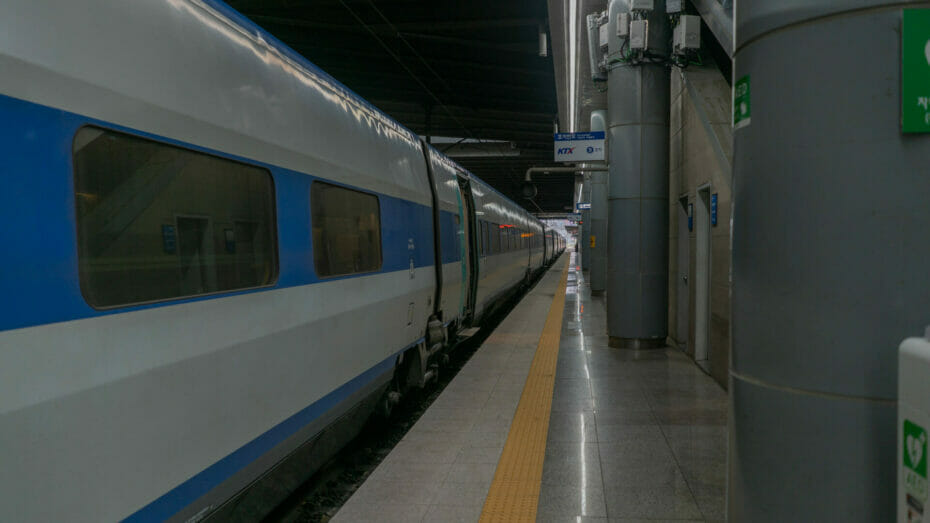
When you enter the station you will have to go through the normal procedure of scanning your transport card (the same that is used for the metro system and buses) and finding the correct platform. This can seem overwhelming at times, but if you follow the direction boards you should have no problem finding the right platform.
Once you get to the correct train, you will find that it is massive. They are rated to hold around 1000 passengers, and the trains have many carriages! How do you find the right one?

On your ticket you will have a carriage and seat number. Something like 9/11B (the one from my ticket above). This means carriage 9, seat 11B. As shown above, each carriage will have a number on the door. Simply find the correct one, and then find your seat within!
You can usually board the KTX very early. I have boarded 45 minutes early. While the train is quite likely to be empty, you can simply walk straight on and take your seat! It’s can seem very confusing, because it seems wrong to just walk on the train without any other procedures. However, this is how the KTX works!
Best hotels near Seoul Station!
KTX Comfort

One thing that impressed me with the KTX was how comfortable and calm the trip was. In many ways, it was similar to taking a flight. However, it was more comfortable.
The interior of the carriages look very similar to what you would expect from a plane. In the economy seats, there are two seats on each side of the aisle. Above the seats, there is a baggage shelf, as well as fan controls for cooling.
Some seats on the train also have access to power sockets (just make sure to have a Korean power adapter!). Unfortunately, not all seats get this benefit. It seems that every second seat row will get access to a power socket and two USB charging ports. There is also WiFi onboard! However, there are time limits and a Korean SIM card might be better.
There are also larger luggage storage areas located on some of the carriages. These are ideal if you have larger suitcases that you are bringing with you on your journey. The KTX also offers bathrooms. Although these are very similar to aeroplane bathrooms, and many people prefer not to use them and to wait until the final destination.
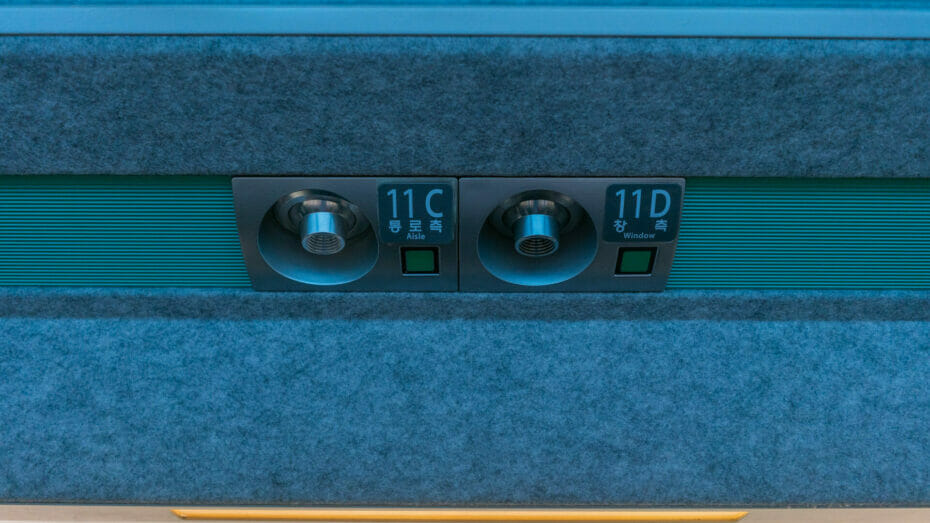
In regards to the feeling of the ride – it feels very similar to a plane. There is a low constant hum of the engines and wheels (although this sound is far less than you would experience on a plane). Although the train is exceptionally smooth, it will move around on the tracks a bit at times which has a similar feel to turbulence.
Interestingly, both my girlfriend and I also noticed pressure in our ears while travelling on the train. While this wasn’t as bad as the popping that can occur on high altitude flights, it was a similar feeling in that we would suddenly get blocked ears and experienced minor discomforts.
This is by no means a big issue, and it only seemed to occur at certain points along the journey. However, it is something to keep in mind.
Another aspect that was very interesting was how… Casual travelling in the KTX is. There are no seatbelts, and there is no time when you must sit down (like there is in a plane). Since the train is so smooth, you are always free to walk around and there is no need for seatbelts.
Overall, the KTX was exceptionally comfortable in regards to the ride itself. It is very smooth and I found that it was definitely a method of transport that I would prefer comfort-wise to travelling via air.
Save money travelling on the KTX with the Korail Pass!
Seating
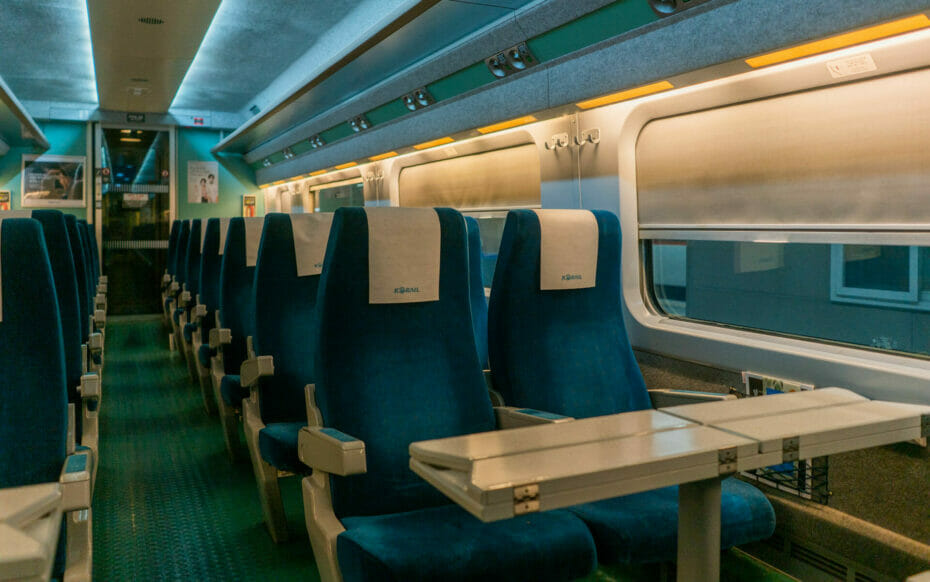
The seating in economy class is also similar to what you would find in a plane. Although the foot space is a bit more than most large aeroplanes, it is definitely less than you will find on the intercity buses in Korea. It’s not uncomfortable, but taller people will begin to notice discomfort after a few hours.
Interestingly, not all seats will be facing forwards. Rather, half of the carriage will face forwards, while the other half will look backwards. In the middle, these seats meet and this creates an ideal place for families to sit.
The seats themselves aren’t extremely comfortable. Again, I would say that they are very comparable to the seats you would find in an aeroplane. There are also pull-up tables and foot-rests that can be deployed for anyone in need.
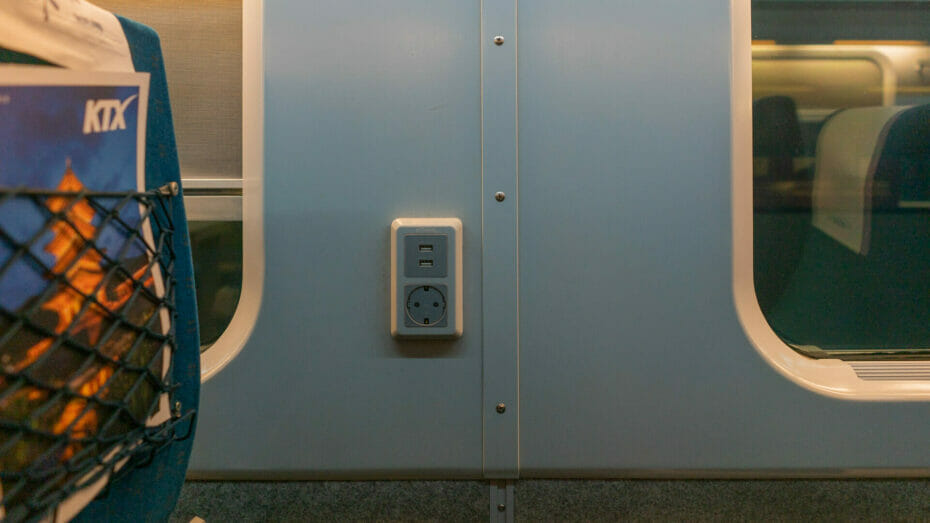
As I mentioned previously, every second row of seats has access to a power socket and two USB ports. While I am unsure if these rows are always the same (odd/even rows), it is a nice benefit for at least half of the train’s customers!
KTX Facilities

The KTX has a lot of facilities, and I was very impressed by this part of the train. Not only are more traditional areas such as luggage storage and toilets provided, but there are also baby changing stations, vending machines, and mobile charging machines.
The graph above shows where these facilities are usually located within a KTX train. Each train will have a map similar to this located between the carriages, and this should allow you to easily find what you might need on the train.
While some of the facilities are essential, it’s nice to see other non-essential facilities such as vending machines and phone charging stations provided. While I would have loved to have seen power sockets on every seat, having a charging station is the next best thing.

As you would expect, the bathrooms on the train aren’t great. They are very small and crowded, so much so that I had a lot of difficulties getting a photograph that could actually show the room. There was not enough room for me to stand back!
Classes

First-class tickets on the KTX cost around 20,000KRW more than the economy tickets. Unfortunately, I don’t have any images from first-class as I’ve only ever used economy myself.
The biggest benefit of first-class is the extra space that it gives you. Rather than there being four seats per row, there are only three. This means that each seat has some more space between the next. There is also more foot-room available, although not that much more.
There are a few other small benefits such as free water and a few snacks, however, there are generally few benefits to upgrading your ticket to first-class. Really, the deciding factor is whether or not you need a bit more space.
Save money travelling on the KTX with the Korail Pass!
Conclusion – KTX, Korea’s Best Form of Transport

I have no hesitation in saying that the KTX is the best form of transport in South Korea. While the whole transport system is fantastic, the KTX is the pinnacle. It’s fast, efficient, and is a good balance between the price of a bus and the speed of a plane.
Rail transport in Korea also makes a lot of sense. Most big cities in Korea have very central stations (think of Seoul Station and Busan Station which are both very central) and this means that you will get off the train and be right in the middle of the city.
Of course, buses do have their place, and they are better for travellers on a budget. However, I highly recommend the KTX for anyone considering which form of transport to take. If you need to travel lots, definitely check out the Korea Rail pass.
KTX FAQ
Where Does the KTX Go?
The KTX serves many cities in South Korea. It serves Seoul, Busan, Daegu, Daejeon, Gwangju, Ulsan, Gangnueng and more. While the KTX itself doesn’t serve some of the smaller cities, it connects to slower trains that do.
Can I Get Cheaper KTX Tickets?
Unfortunately there are no third-party websites or locations in which you can purchase KTX tickets. However, the Korea Rail Pass is a great option for saving money if you plan to travel lots.
Is the KTX Cheaper Than Flying?
Usually, but not always. The KTX starts at around 40,000KRW to Busan, however, mid-week flights can be found as low as 30,000KRW.However, the KTX is more consistent with its pricing, and it tends to be cheaper at busier times.
How Fast Does the KTX Go?
The KTX will speed up and slow down as it travels through the countryside and cities. However, it can reach speeds in excess of 300km/h. Usually, it will sit between 250km/h and 300km/h.
Where Can I Catch KTX?
There are many stations in Seoul that house KTX. However, most trains (and especially those to Busan) will depart from Seoul Station.


Hi! You said there is almost zero chance that my ticket will be checked but what about the “you need to scan your transport card when you enter the station and look for the right platform”? This is a bit confusing I mean why should I use my transport card to look for my ktx platform? Will my transport card be charged?